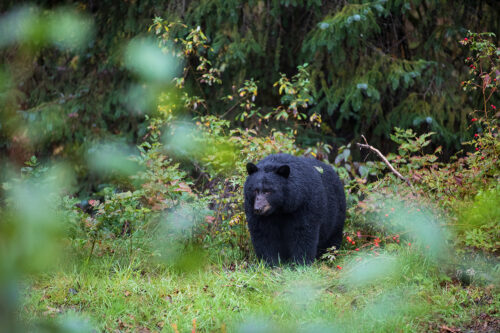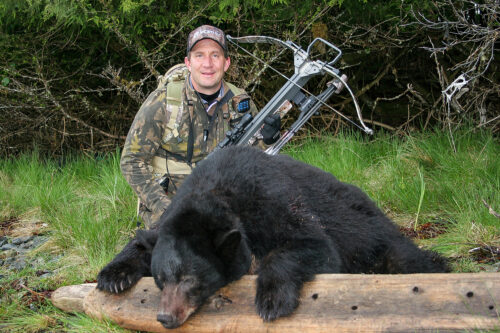
Here Comes The Judge: How To Size Up The Bear You Want To Hunt
The following appears in the May issue of Alaska Sporting Journal:

BY SCOTT HAUGEN
I’ve been fortunate to take many bears in Alaska – black bears, inland grizzlies, coastal browns, even a man-eating polar bear when I lived in Point Lay in 1990. While I’ve shot a fair number of bears, dozens of them, I’ve observed hundreds more throughout Alaska and across the Western U.S. and Canada. I like hunting bears and love watching and photographing these predators.
No matter what subspecies of bear you’re hunting, big bears exhibit the same general features, except for big male polar bears, which have exceptionally long necks in comparison to their head and body. But few of us will ever hunt those particular animals.
For most hunters looking for a bear to shoot, they want a big one. I rank bears as the toughest big game animal to field judge in North America, but there are signs to look for to efficiently evaluate the size of the bruin you’re looking at. These are the five things I look for when sizing up bears.
BEAR SWAGGER
The number one factor I look for to determine if a bear is big is its walk. Even from over a mile away, the swagger of a bear reveals its size and, sometimes, its age. If a big boar struggles to walk with ease, or it looks painful for the bear to move, or it’s moving very lethargically, it’s likely a very old boar. Obviously, such movements won’t reveal exact age, but it can lead to a guesstimate of age, which is a good indicator of a bear’s ability to reach its full genetic potential in the area you’re hunting.
When walking, if a bear’s bulky hindquarters seem to rotate independently of its front shoulders – almost like they’re two separate units – then you’re looking at a big bear. Bears with thick hind ends will also appear to walk stiff-legged. The bigger a bear’s hind end in proportion to the front shoulders, the greater the chance you’re looking at an animal worth taking.

THICK FRONT LEGS
The second thing I look at to determine if a bear is big is its front legs. If the shoulder and elbow are the same width with no evident elbow being seen when the bear stands broadside, then it’s a mature bear. If the width of the leg continues all the way down to the paw, it’s an old bear, likely one worth putting your tag on.
If you see a visible flip of the wrist – the front foot – when a bear takes a step, you’re looking at a small bear. This, in itself, when all other factors check out, can save you from shooting a small bear. Big bears have big feet and wrists, period.
The greater the thickness in the lower leg to where it matches the width of the shoulder, the bigger the bear. When looking at a bear head on, the thick front legs on a big bear will appear bow-legged, which will be evident when they walk. The legs will still maintain the thickness from top to bottom; they’ll just be bowed in the middle.
TRIANGULAR FOREHEAD DIVOT
Third on my checklist for evaluating bears to see if they’re big is their forehead. If the forehead is flat or rounded and smooth, it’s not an old bear. If the hair on the forehead seems long with no muscle division, it’s likely a young bear. But if there’s a triangular divot in the center of a rounded forehead, just above the eyes, you’re staring at one big bear.
This triangular divot forms below where the cranial muscles attach to the upper back half of the skull, along the cranial ridge. The bigger the muscles atop the head, the bigger this divot will be. The divot is more visible in black bears than brown or grizzlies due to the color and length of hair.
If the divot is evident but seems more elliptical than triangular and runs from above the eyes to the center of the bear’s head, it’s likely a mature bear but not a monster. If there’s a definite triangular divot situated above what looks like thick muscle and dense fur between and slightly above the bear’s eyes, then you’re looking at a shooter.

EARS
“Look at the ears!” It’s the first reaction I hear from fellow hunters when talk centers around judging whether a bear is big or not. I bite my tongue for as long as I can and then chime in, because it’s the fourth point in my evaluation checklist. It’s not until after I study a bear’s walk, check out the front leg width and locate a triangular divot in the forehead that I turn my focus to the ears of a bear.
I’ve killed some monster bears with ears not fully turned out to the side of the head, as many people claim is the top sign of a big bear. I’ve also shot bears with big ears; not tiny ones that are barely visible to the hunter’s eye. Think of how the size and shape of human ears differ; bears are no different.
Generally speaking, if a bruin’s ears appear small and turned out to the side of the bear’s head and all other checkpoints have held to my standards, then it’s going to be a shooter. On really big bears with well-developed cranial muscles, the tips of the ears will actually lay slightly below the top of the head – almost drooping down.
The bulging forehead muscles that create the triangular divot are the same muscles that push the ears to the side of the bear’s head as it ages. The larger and more developed these muscles, the farther to the side of the head the ears are set.
That said, this isn’t always true, as some bears use these cranial muscles to a lesser degree, since food where they live may be easier to come by and chew. For example, bears that live an easy life catching salmon don’t seem to have the cranial muscle development of inland bears that have to continually dig for food and vigorously kill and devour big-boned prey.
If the ears appear pointed and sitting atop the bear’s head, you’re always staring at a small bear. If the ears are slightly turned out to the side but still appear pointed, you’re looking at a good bear–butnotagreatone–soholdoffif shooting a monster is your goal.

SAGGING BELLY
The fifth factor I look for when looking for a bigger bear is a sagging belly. If all the other points check out and the bear has a big, round and drooping stomach, it’s going to be a big bear. Remember that sows, yearlings and even subadult males can have a sagging belly, which is why all other checkpoints must first be confirmed before evaluating this one. Not all roly-poly bears are big; some are yearlings that won’t weigh 100 pounds but may appear large to a novice bear hunter nonetheless.
A bear’s sagging gut can be relative to the area being hunted, the time of year, availability of food, plus how harsh the previous winter was. One of the biggest bears I’ve seen had 2 feet of daylight under its belly, but because the other four checkpoints proved favorable, that bear was a shooter, and it was giant both in terms of squared hide and skull.
Bears are driven by food, and as fall progresses, the bellies of a mature bear should nearly be dragging the ground as they prepare for a long winter’s nap. Alternatively, if they’re just coming out of the spring den, bears can be very lean in the midsection.

SQUARED HIDE AND CLEANED SKULL
Bears are field judged in two ways: the size of the squared hide and the measurement of the skull. The skull, which is what qualifies bears for record-book entry, is impossible to judge with precision while the bear is still alive. This is because these measurements are taken once the skull is cleaned of all flesh and fat, and dried out so it’s just bone. There’s no way to tell how wide and long the actual skull of a live bear is under all that fur and muscle. But generally speaking, if the aforementioned five points check out, that bear will be a very big one for the area where it lives.
Likewise, my five field-judging tips are accurate but not exact when determining the squared hide measurements of a bear, another benchmark hunters use to decide if a bruin is big or not. More than a skull measurement, the squared measurement of a bear hide is the standard most hunters go by. Mind you that a brown bear that squares 10 feet does not mean it stands 10 feet tall when on its hind legs. A squared measurement is when you take a bear hide that’s been removed from the bear by slitting up the belly from the base of the tail to the neck; then across the chest from front paw to front paw, and across the rump from back paw to back paw.
The freshly removed hide is then laid flat on the ground and measured from nose to tail and from front claw to front claw. Those two figures are then added and divided by two. If they check out, that’s a squared bear hide. Do not pull and stretch the hide, and don’t have buddies tugging on all four corners. Also, don’t nail it down all stretched out and lay a tape to it. Squared measurements are to be taken on a relaxed hide that’s laying flat.
Accurately judging a bear’s size while it’s still alive is challenging. In the end, it’s not the size of the skull or the numbers tacked to a hide that you’ll most remember about your bear hunt. What you’ll most recall, and appreciate, is how hard you worked to find, evaluate and take a mature bear, which is the goal of many seasoned bear hunters. ASJ
Editor’s note: Want to learn how to skin and break down a bear? Order Scott Haugen’s popular DVD, Field Dressing, Skinning & Caping Big Game, at scotthaugen.com. Follow Scott’s adventures on Instagram and Facebook.



